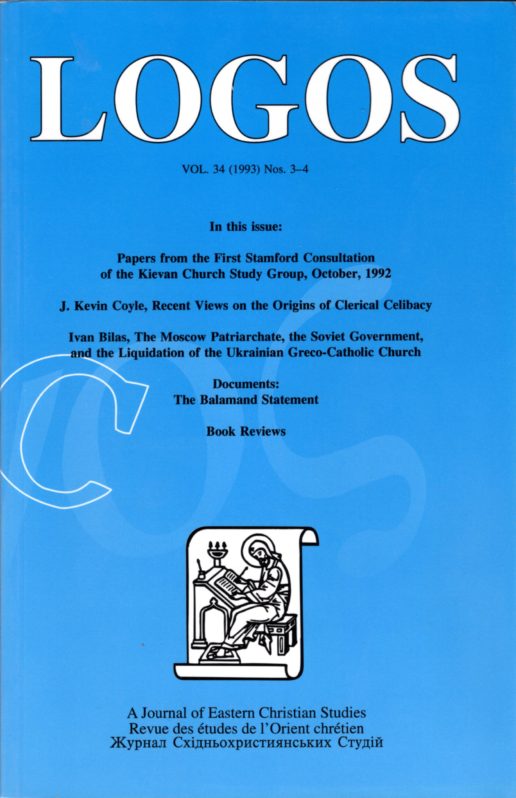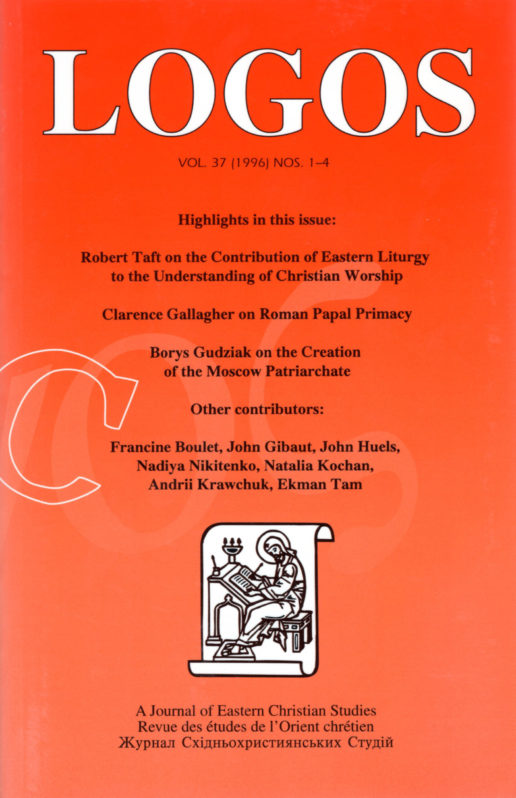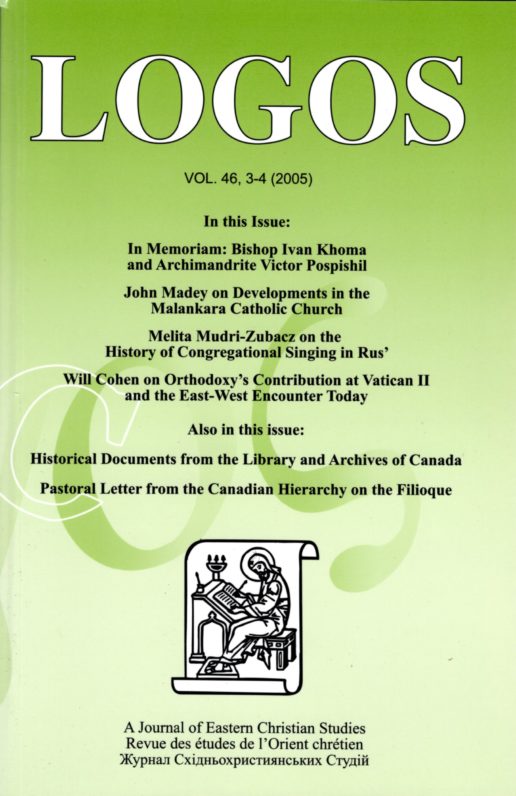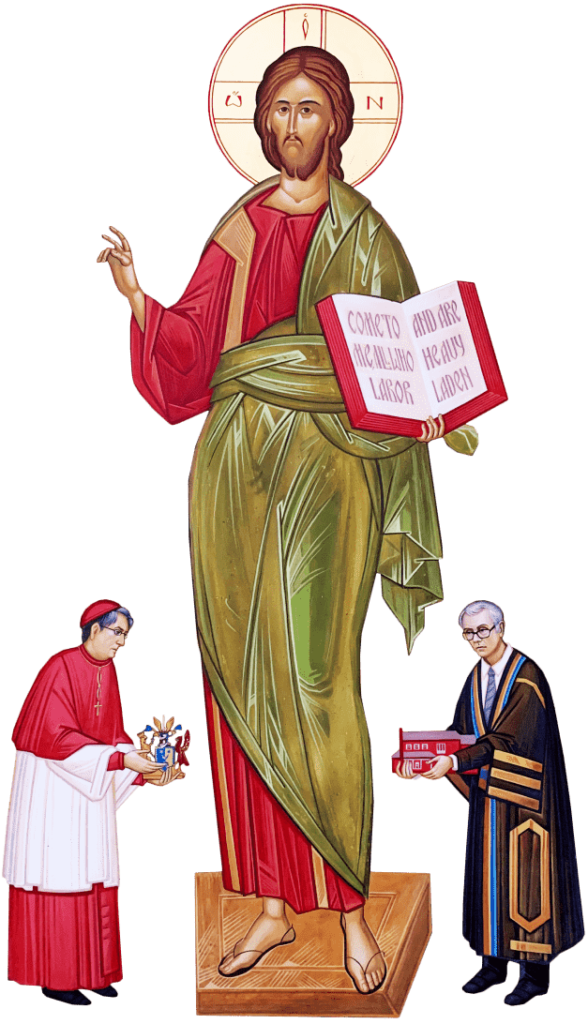Description
Table of Contents (PDF)
Editorial
Andriy Chirovsky (1)
Papers from the McGill University Conference, “The Spiritual and Intellectual Legacy of Metropolitan Andrey Sheptytsky,” November, 2001
Metropolitan Andrei Sheptytsky and the Religious “Tool-Kit:” A Re-Assessment of His Role in Early Ukrainian-Canadian History
Miroslaw Tataryn (11)
Abstract
The author provides a sociological analysis of Sheptytsky’s relationship to Ukrainian Catholics in the first wave of immigration to Western Canada in the early 1900s. The author, in the light of several contemporary sociologies of religion and immigration, argues counter-intuitively that religion in a time of “unsettled lives” is not always a conservative factor but can create new and dynamic “strategies of action.” In the formidably new Canadian prairies, the Ukrainian immigrants were not passive “sheep,” content with their spiritual desolation and isolation, but drew on their cultural “tool kit” to create ways to address the lack of priests and spiritual leadership, a lack which Sheptytsky initially did not understand but would later address when the threat of Ukrainian Catholic immigrants joining up with Presbyterians and French Roman Catholics came to the fore. Both groups would prove unsatisfactory, and so the 1918 creation of the Ukrainian Greek Orthodox Church came about. The author critically suggests that such a development was, at least sociologically speaking, not so much a complete failure as the “culmination of a dynamic and vital process of self-definition and cultural survival.”
Резюме
Автор застосовує кілька нових соціологічних теорій для того, щоб арґументувати, що неспокій та заворушення серед перших українських еміґрантів до Канади, які здебільше були греко-католиками, наштовхнуло їх шукати нових способів для вирішування релігійних проблем. Незважаючи на те, що часто буває, що еміґрування веде до певного консерватизму, перші іміґранти в Західню Канаду розв’язали проблему браку священиків тим, що створили Українську Греко-Православну Церкву Канади. Та ще перед тим дехто з них готовий був “експериментувати” можливість творення української “вітки” пресвітеріянської Церкви. Автор уважає, що ці спроби були виявами динамічного мислення та дії перших еміґрантів.
Metropolitan Andrey Sheptytsky: A Pioneer of the Sister Churches Model of Church Unity? (PDF sample)
Ihor George Kutash (31)
Abstract
The author, an archpriest of the Ukrainian Orthodox Church in Canada, provides a history of the ecclesiological development of Metropolitan Andrey Sheptytsky, demonstrating his remarkable prescience in laying the groundwork for later treatment of the Orthodox Church as a “sister Church,” a model for ecumenism that would not find voice again in a significant way until after Vatican II when the international Orthodox-Catholic dialogue took it up, basing itself less on a universalist and more on a eucharistic ecclesiology. Sheptytsky’s pioneering endeavours sowed seeds for Catholics in particular to move beyond “soteriological exclusivism” and to recognize in Orthodoxy a venerable and valid means of salvation. Sheptytsky manifested an openness to, and solicitude for, Orthodoxy, as seen in: his refusal to use the epithet “schismatic” when speaking of them; his hospitality to Orthodox hierarchs; and his letter of 30 December 1941 which called for openness and unity. The author concludes by noting how these hopes have continued to grow in the six decades since Sheptytsky’s death.
Резюме
Протоієрей Української Православної Церкви Канади описує прото-екуменічні почини Митрополита Андрея Шептицького. Греко-католицький архиєпископ став предвісником православно-католицького богословського діалогу тим, що поклав підґрунтя для розвитку моделюm “сестринних Церков.” Шептицький наказував не користуватись терміном “схизматик” у відношенню до православних; він неодноразово гостив у себе православних єпископів – отим розбуджуючи невдоволення серед недругів східнього християнства та українського народу; та започаткував надзвичайно приязне листування до православних єпископів у 1940-вих роках.
Metropolitan Andrei and the Orthodox (PDF sample)
Archbishop Vsevolod of Scopelos (41)
Abstract
Orthodox Archbishop Vsevolod briefly reviews the history of the Church in Ukraine, concentrating on the various ecclesiastical and geopolitical separations that allowed Greco-Catholics and Orthodox to be indifferent to one another, a situation that Metropolitan Andrey Sheptytsky was to challenge throughout his life. His early travels to Eastern Ukraine, Russia, Bukovnya (with its Old Ritualists) and the Holy Land gave him a sense of the breadth of Orthodoxy and a desire to overcome estrangement with them. This desire would be manifest later in his archpastoral ministry by: instructing his clergy to offer the sacraments to Orthodox faithful who asked for them; offering hospitality in 1919 to Orthodox hierarchs, who made use of the chapel in Sheptytsky’s palace for Divine Liturgy; working on the creation of a superlative Studite Typicon; creating liturgical books based on the best Orthodox sources and still in use today by some; setting up the Ukrainian National Museum in Lviv; erecting the Russian Greco-Catholic Exarchate; and defending Orthodox who were persecuted in Eastern Poland. Kyr Vsevolod concludes with a detailed study of Sheptytsky’s 1941 open letter to Orthodox hierarchs, which reveals him as decades ahead of his time in ecumenical thought.
Резюме
Архиєпископ Української Православної Церкви Америки описує, як то широкий досвід Митрополита Андрея Шептицького, здобутий під час його подорожей в Росію, Східню Україну, Буковину та Святу Землю, приготовив його до праці в справі католицько-православного зближення. Це виявилося конкретно в його рішенні причащати православних; влаштувати каплицю для православних єпископів, які перебували в нього; та обороняти православних волиняків під час т.зв. ревіндікації, коли представники міжвоєнного польського уряду нищили православні храми або намагалися перетворити їх в костели.
Lev Gillet (“A Monk of the Eastern Church”) and His Spiritual Father, Metropolitan Andrei Sheptytsky: An Analysis of Their Correspondence, 1921–1929 (PDF Sample)
Peter Galadza (57)
Abstract
By means of original research at the Sheptytsky archives in Lviv, the author uncovered a file of some seventy handwritten letters between Metropolitan Andrei Sheptytsky and his sometime spiritual son, Lev Gillet (“A Monk of the Eastern Church”), a file which sheds important light on the biographies of both of these influential churchmen and also on interwar history. This correspondence, dating from the first meeting of the two in 1921 through to Sheptytsky’s receiving of Gillet into the Studites and then Gillet’s entrance into Orthodoxy in 1928, is analyzed to reveal several key incidents in the decade, including: Ukrainian political aspirations after Poland took over Eastern Galicia; Eastern Catholic expansionism into former Tsarist territories; the questionable work of Michel d’Herbigny and Pius XI’s Mortalium animos; and the creation of Chevetogne. In addition, the letters reveal subtle developments in the thinking of both Sheptytsky and Gillet as well as their relations with such ecumenically significant figures as Dom Lambert Beauduin, Leonid Fiodorov, and the Orthodox pioneers of Saint Serge Institute in Paris. Even to the end of his life, Gillet referred to Sheptytsky as “my bishop” and the correspondence concludes with a poignant exchange as the son realizes the pain he is causing his father, but asks nonetheless for the freedom to follow his conscience – a move that might have been avoided had the politics of “soteriological exclusivism” not been so severe at the time.
Резюме
У 1992-му році автор віднайшов листування французького ченця Льва Жіллета (“Монаха Східньої Церкви”) до Митрополита Андрея Шептицького за років 1921–1928. Доволі велика кількість листів – понад 70 – та щирість і обширність їхнього змісту помагають історикові ще краще насвітлювати деякі моменти в житті Митрополита та й його колишнього франкомовного секретаря. Шептицький прийняв Жіллета до студитів і висвятив його в священики. Згодом вислав його до Франції, де він мав працювати над заснуванням студитського монастиря в Західній Европі. Скорочення повновластей Шептицького деякими ватиканськими чиновниками та поява папської енцикліки Mortalium animos, яка заборонила католикам брати участь в екуменічному русі, так розчарувала Жіллета, що в 1928 році він перейшов на православ’я, хоч до смерти настоював, що він не покинув католицизму, а тільки ввійшов в сопричастя з православними.
Articles
Convoluted Conjugality: Hymnographic Repression, Transference and Co-optation in the Byzantine Sanctoral’s Commemoration of Married Saints (PDF sample)
Brian Anastasi Butcher (83)
Abstract
The author examines the hymnography of the Byzantine Menaion in order to identify and critically analyze the theology of marriage in its texts. The first part surveys the theology of marriage in various Eastern authors, including Alexander Schmemann (whose methodology for liturgical theology is employed), Stavros Fotiou, William Basil Zion, David Petras, Paul Evdokimov, Michel Evdokimov, John Meyendorff, Bishop Kallistos (Ware), Archbishop Peter (L’Huillier), John Chryssavgis, and Anthony Ugolnik. This theology is then analyzed vis-à-vis the texts of various saints found in the Menaion, a work which, the author suggests, presents a radically different picture of marriage by treating married saints (whom he divides into righteous Israelites, martyrs, celibate spouses, absentee husbands, monastic widows, and “wonder women”) through one of three means: a repression of mention of their marriage, a transference of their struggle in marriage into a monastic milieu, or a co-optation of them for other disembodied purposes. He concludes with reflections on what work needs to be done to repair this wide chasm between Byzantine lex credendi and lex orandi.
Резюме
Автор аналізує твори 11-ох богословів, які пишуть про подружжя зі східньо-християнської перспективи і доказує, що існує конфлікт між їхніми (позитивними) твердженнями про це таїнство та ідеями про подружжя, які знаходяться в Мінеї. У повній Мінеї, служби одружених святих можна поділити на: і) праведних старозавітних супругів; іі) мучеників; ііі) супругів, які таки подружніх стосунків не зазнали; іv) чоловіків, які покинули свої сім’ї; v) вдовиць, які стали монахинями; та vi) жінок, які втекли від своїх супругів до мужеських монастирів, де вдавали, що вони мужчини. В мінейних службах майже нема згадки про духовні чи, взагалі, позитивні зусилля подружнього життя. Це ставить під сумнів традиційне гасло lex orandi, lex credendi, оскільки в мінейній гимнографії годі знайти подвижників сімейного життя, незважаючи на те, що подружжя – це Таїнство Церкви.
Rome’s Liturgical Instruction for the Eastern Catholic Churches (PDF sample)
George Gallaro (149)
Abstract
By means of a detailed study of the 1996 Vatican document, Instruction for Applying the Liturgical Prescriptions of the Code of Canons of the Eastern Churches, as well as the Code itself, the author attempts to assist Eastern Catholics in the process of returning to their roots and eradicating whatever is foreign to their rich liturgical and spiritual patrimony as mandated by the Second Vatican Council and subsequent Roman documents, especially those of Pope John Paul II. The author concentrates on the structures of Eastern Catholic Churches and their lawful autonomy and authority before focusing on several key areas, including: the publication of liturgical books; liturgical formation of seminarians; the proper celebration of the sacraments of initiation, healing, and vocation; sacramentals; the sanctoral cycle, including days of feast and fast, and the importance of lost traditions such as the Lenten Liturgy of the Pre-Sanctified Gifts; the spiritual necessity of recovering public celebration of the Liturgy of the Hours; and the role of icons. He concludes with an appeal for the full restoration by Eastern Catholics of their liturgicotheological heritage for its own sake as well as for the sake of Orthodox-Catholic unity.
Резюме
Мелхітський священик, Джордж Ґалларо, аналізує Інструкцію застосування літургійних приписів Кодексу Канонів східних Церков, видану 1996-го року Східньою Конґреґацією. Він звертає особливу увагу на видання літургійних книг, і те, що Рим бажає, щоб якомога східні католики співпрацювали з православними в цій справі. Щодо вишколу семінаристів, Інструкція підкреслює, що від цього залежатиме літургійне відродження Церков. На жаль, велике число семінарій далі занедбує цей аспект душпастирської формації. Далі існують випадки, що Церква не причащає немовлят; та Літургія Ранішосвячених Дарів занедбана. В багатьох випадках, єпископи навіть толерують відправлення Літургії Золотоустого в будні дні Великого Посту. Також, незважаючи на заохоту, висловлену ще в 1960-их роках стосовно відродження всенародного відправлення Вечірні і Утрені, парафії, на загал, цього не роблять. В минулому була тенденція голосити, що це все потрібне для того, “щоб притягнути православних до католицької Церкви”. Сьогодні, незважаючи на важливість цього “екуменічного” моменту, підкреслюється, що саме духовне і богословське відродження східних католиків вимагає оживлення автентичних східних традицій.
The Catholic Syro-Malankara Church: Some Reflections on Its Canonical Status Past and Future (PDF sample)
John Madey (181)
Abstract
Knowledge of the Eastern Catholic Churches is generally very low, and the Syro-Malankara Church is particularly recondite to most. The author provides a very detailed exposition of the nature and structure of this Church sui iuris which enjoys communion with the See of Rome and therefore the other twenty-two constituent members of the Catholic Church. The author gives a detailed history of this Church’s activities on the Indian Sub-Continent, including its entrance into Catholic communion, before concentrating on the canonical forms – and revisions needed thereto – of the structure of the Syro-Malankara Church in light of the 1990 Code of Canons of the Eastern Churches. The author concludes with an appeal for the status of this Church to be set aright in light of Eastern tradition, with the head of the Church being recognized as pater et caput based on the model of a majorarchiepiscopal Church with its own autonomy, synodical government, and Catholicos. Such a move would strengthen the Church internally and also assist her external ecumenical witness.
Резюме
Відомий знавець східнього католицизму, зокрема в Індії, подає детальний опис історії та теперішнього стану Маланкарської Церкви. Вона ввійшла в сопричастя з римським престолом щойно в 1930-му році. Однак, на думку автора, вона посідає всі прикмети та атрибути, щоб бути піднесеною до статусу верховного архиєпископства.
Romanus the Melodist: Drama as an Instrument of Theology (PDF sample)
Matthew Schroeder (203)
Abstract
By means of a close reading among several texts of Greek antiquity, the author demonstrates that in the hymnography of Saint Romanus the Melodist we see the advent of a new dramatic religious genre in the Byzantine tradition. By combining the schematic plots of the classical dramatist Euripides with a new poetic form, the kontakion, Romanus was able to provide the Church of his day with a vehicle for expressing and conveying her faith in the Triune God. Like its predecessors in the classical tradition, the kontakion was meant to produce in those who listened to it feelings of awe and understanding. Romanus’s poetic works are the product of a complicated and intricate inculturative process that took several centuries to fully mature. In his works, a synthesis of Syriac form and classical dramatic and rhetorical convention has been created that is nearly perfect. Nevertheless, in the inculturative process we witness a collision of two different cultures that leads, ultimately, albeit haltingly, to a harmonious blending of the two cultures into a new culture, in the process giving birth to a theology that is at once dramatic and liturgical.
Резюме
У візантійській літургійній традиції існує форма гимнографії, яка називається кондак. Одначе, сьогоднішній кондак своєю формою далеко відбігає від історичного кондаку. Первісний кондак звичайно складався з понад 20-ти параграфів (ікосів) і отим нагадував сьогоднішній акафіст. Він з початку був немовби співаною проповіддю. Вершком компонування кондаків – це 6-те століття, період Романа Сладкопівця. В цій статті автор арґументує, що Роман злучив елемент класичної драми із школи грека Еврипида із формами сирійської поезії. Романові йшлося про те, щоб розбудити в слухачів почування подиву, так як під час класично їдрами. Отим Роман став черговим християнським богословом, якому вдалося “інкультурувати” християнське вчення.
Whose Saints? How Much Can We Recognize Holiness beyond the Pale? (PDF sample)
Ron (Serafim) Grove (253)
Abstract
The author examines what might be called “cross-confessional” or “trans-jurisdictional” sanctity, i.e., figures accounted as “saints” in one Church who are also venerated as such by another Church which may not be in communion with the canonizing Church and may indeed even be otherwise vigorously opposed to their theology and practices. The author explores this often-contradictory phenomenon as it is found in Oriental and Eastern Orthodox Churches, Eastern and Roman Catholic Churches, and in Protestant bodies, analyzing particularly the liturgical calendars of each. In addition, and by means of contrast, the author also provides a brief analysis of “saint-making” as it occurs in some secular circles and non-Christian religions, especially Judaism and Islam. This analysis reveals several things: that veneration of holy figures is a catholic practice not confined to explicitly religious people but seems almost globally humanly ingrained; that such veneration often proceeds quite independently and “democratically” as people venerate holy figures irrespective of decisions made about them by their leaders; and that such veneration highlights (sometimes almost comically so) a theological incoherence that can be nonetheless ecumenically useful as people today seek out spiritual relationships with those once accounted heretics and enemies. The author concludes with a salutary warning not to assume too blithely that “if our saints are true, yours must be false” because in the search for Christian unity accommodations will eventually have to be made in hagiographical canons and liturgical calendars.
Резюме
Стаття православного диякона розглядає питання визнання святих однієї Церкви чи релігійної спільноти іншими Церквами та релігіями. Він доказує, що навіть нерелігійні люди творять своїх “святих”; що почитання святих – у цьому випадку святих у звичайному розумінні того слова – нераз включає праведників іншої конфесії–без апробату ієрархії; та що, незважаючи на деякі майже комічні випадки, такий “синаксарний екуменізм” може допомогти християнам зблизитися. Це питання зокрема важливе на християнському Сході, тому що поодинокі святінераз стають символами розколу. Герої-святі нехалкедонських (монофізитських) Церков, наприклад, даліпо-іменно засуджені православними Церквами, незважаючи на те, що не-халкедонські та православні Церкви з року в рік зближуються. Сьогодні члени цих Церков часто причащаються один в одного з дозволом своїх ієрархів.
La Liturgie Pénitentielle des Églises Syriaque et Copte (PDF sample)
Elias El-Hayek (295)
Abstract
Arguing that penitential discipline is a crucial component of the liturgico-spiritual patrimony of both the Coptic and Syriac traditions, the author demonstrates that both traditions offer a much more “therapeutic” understanding of penitence whose indebtedness to Jewish tradition is more clearly seen than in the frequently more juridical and individual approaches common in Western traditions. In particular, the author focuses on non-eucharistic penitential services and penitential aspects of eucharistic liturgies which have the effect of underscoring the wounds a community endures when a member sins, and the healing a community can mediate to revive and restore that member when he repents. The author also discusses the different approach taken to the question of a taxonomy of sins, arguing that figures like Theodore of Mopsuestia and Ephraim the Syrian have developed an understanding of sins which require individualized therapeutic intervention by a priest in auricular confession alongside those that require no such attention directly and can be dealt with through liturgical action in the sacrifice which is the divine Eucharist. The author concludes with an analysis of the “prayers of pardon” in the Syriac (east and west) and Alexandrian anaphoras, which are compared with others, including the Nestorian.
Резюме
В літургійній практиці сирійської та коптійської Церков наголошується на покаяння як на зцілення. Це походить з деяких аспектів старозавітнього вчення про гріх. Так як усі класичні літургійні традиції, сирійська та коптійська посідають різні покаянні богослуження та, крім цього, сама євхаристійна Служба включає покаянні елементи. Автор арґументує, що наголос на покаяння “в спільнотному контексті” дає християнам можливість зцілити міжусобні рани, які часто або наштовхують на гріх, або є симптомами гріха. Мислення Теодора з Монсуестії та Єфрема Сирійця виявляє двоякий підхід до покаяннясповіді. Окрім можливости особистого визнання гріхів перед представником Церкви, сама Євхаристійна Жертва, зокрема в анафорі, відзначається наголосом на відпущення гріхів.
The Evangelical Potential of the Byzantine Liturgy in Culture of Efficiency and Death (Sample PDF)
Adam A.J. DeVille (315)
Abstract
Building upon earlier analyses of Pope John Paul II’s encyclical Evangelium Vitae (“on the gospel of life”), the author argues that the Catholic Church is undergoing its own internal crises concomitant with the most profound disaster in Western culture of our time, abortion. Noting that reputable scientific statistics record over fifty million abortions around the world each year, the author unfolds the papal analysis of this crisis to reveal at its heart a metaphysical structure of evil whose core value is that of efficiency. Following Josef Pieper’s argument that efficiency can only be transformed through a renewed culture of leisure, which itself is inexorably bound up with a renewed celebration of liturgy, the author then argues that the transformation necessary to build what John Paul II calls a “culture of life” may come in part through liturgy. Following the liturgical scholarship of Alexander Schmemann, Joseph Ratzinger, and Catherine Pickstock, together with the work of Robert Taft and Romano Guardini, the author undertakes an analysis of the structural repetitions built into the Byzantine Liturgy of Saint John Chrysostom, focusing in particular on the several litanies which recur throughout that liturgy, to argue that such repetitions point to a unique liturgical ethos which may be useful in an evangelically counter-cultural witness whose goal is the transformation of a culture of efficiency into a culture in which children are welcomed to engage in “holy play” before their heavenly Father.
Резюме
Венцикліці Evangelum Vitae Папа Іван Павло ІІ проаналізував те, що він назвав сучасною “культурою смерти.” Кожного року приблизно 50 мільйонів дітей вбито в утробі. Між основними причинами цієї кризи людської цивілізації є метафізична “структура зла”, яка вкорінена в світогляді, в якому панує “продуктивна справність” (efficiency). Тільки відновлена культура “дозвілля – відпочинку” (leisure) може дати опір цій гонитві за “справністю”. Автор арґументує, що “етос” і дух Літургії візантійського обряду є здатні поборювати сучасну “культуру справності”. Літургія виявляє “дитячу забавність”, яка не має за ціль будь-якого “результату”. Постійні “непотрібні повторення” Літургії семіотично голосять, що існує вища ціль від “цілеспрямованої продуктивности.” Сучасна людина, огорнута любов’ю небесного Отця, мусить знову навчитися, що означає просто “бути”, для того, щоб зрозуміти, що людське життя є безмежної вартости.
Notes, Essays, Lectures
The Life and Times of Peter Mohyla, Metropolitan of Kiev (PDF sample)
Ronald P. Popivchak (339)
Abstract
The author, one of only a handful of active Mohyla scholars of the last quarter-century, provides an overview of this enormously influential reformer of ecclesiastical life in Ukraine, including his biographical and historical milieu in Reformation and Counter-Reformation Europe. Mohyla, recently glorified as a saint by the Orthodox Church, possessed a brilliant mind able to manoeuvre between many conflicting ecclesial and political currents before emerging at an astonishingly young age as metropolitan of Kiev, a position from which he reformed and restored to great heights the Church of his day. His accomplishments analyzed here include his reformation of the clergy of his day; formation of the famed Mohyla Academy, the first institute of higher learning in Ukraine and a model for Slavic Europe; and publication of so many works that his erudition and ambition continue to amaze. Several works are examined here, including the Lithos Albo Kamen of 1644; his Trebnyk of 1646; his various lives of the saints; and then his famous Orthodox Confession of Faith, which influenced all of Orthodoxy and is analyzed here in detail as one of the greatest lasting achievements of the Church of Kiev.
Резюме
Автор, український греко-католицький священик, який в 1970-их роках захистив докторську працю про Ісповідь Віри Митрополита Петра Могили в Католицькому Університеті Америки, підсумовує науково-богословські досягнення київського митрополита аналізуючи його головніші праці, як також і старшу літературу про нього.
“Віки вічні” чи “віки віків”? (PDF)
Петро Ґаладза (361)
Abstract
The author demonstrates that “i na viky vichni,” the translation of the embolism e„j toÝj a„înaj tîn a„ènwn that has gained currency among Ukrainian Catholics since 1988, is not only inaccurate, but erroneous. It became dominant among the Ukrainian Orthodox owing to the work of Ilarion Ohienko, who had argued for a rejection of “i na viky vikiv” on purely philological grounds, without a consideration of theology. In the 1980s, a prominent Ukrainian Catholic hierarch had insisted that in the interests of “uniformity” with the Orthodox, the shift be made by Ukrainian Catholics to the (inaccurate) translation “i na viky vichni.” The change was then codified in several official publications of the UGCC. Ironically, the Ukrainian Orthodox, both in Ukraine and in the West, have now rejected the erroneous translation in their new liturgical books, leaving the Ukrainian Catholic Church to perpetuate the mistake.
Book Reviews
M. Basil Pennington, OCSO. The Monks of Mount Athos: A Western Monk’s Extraordinary Spiritual Journey on Eastern Holy Ground
Adam A.J. DeVille (369)
Jaroslav Z. Skira and Myroslaw I. Tataryn, editors. Windows to the East: Eastern Christians in a Dialogue of Charity
Adam A.J. DeVille (372)
Roman Cholij. Theodore the Stoudite: The Ordering of Holiness
Peter Galadza (375)
Maria Vassilaki, editor. Mother of God: Representations of the Virgin in Byzantine Art
Eugene Ludwig (379)
Contributors (383)
Language: English, French, Ukrainian
Softcover: viii, 408 pages
Publisher: The Metropolitan Sheptytsky Institute of Eastern Christian Studies
ISSN: 0024-5895
Digital File: $22
Size: 2 MB
A link to the PDF file of this title will be sent to you. The PDF file is for your personal use only. You may not copy, share, publish, or sell the file. Protected by copyright of the Metropolitan Andrey Sheptytsky Institute of Eastern Christian Studies.






